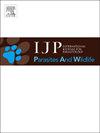Validation of a species-specific probe-based qPCR for detection of Setaria yehi (Filarioidea: Onchocercidae) in Alaskan moose (Alces alces gigas)
IF 2
3区 医学
Q3 ECOLOGY
International Journal for Parasitology-Parasites and Wildlife
Pub Date : 2024-09-12
DOI:10.1016/j.ijppaw.2024.100990
引用次数: 0
Abstract
Northern ungulates contend with Setaria yehi and Rumenfilaria andersoni, filarioid nematodes that are transmitted by ectoparasitic blood-feeding arthropods, which can result in animal and population level impacts. Setaria yehi microfilariae can be detected in fresh blood samples using a modified Knott's test, or by postmortem detection by genetic sampling or through the retrieval of adult specimens in the peritoneal cavity. In this study we validated a novel qPCR for detection of S. yehi DNA in blood samples of moose (Alces alces). Additionally, we compared quantitative values from modified Knott's test to detect both S. yehi and R. andersoni from both fresh and frozen blood samples. Species-specific primers targeting a 121-base pair fragment of the cytochrome oxidase c subunit 1 (cox1) of S. yehi, and a species-specific probe were designed. The qPCR had a detection threshold of 0.157 pg/μL of parasite DNA. We collected 166 blood samples from wild moose captured on the Kenai Peninsula, Alaska from 2019 to 2022. Matching blood aliquots were tested by modified Knott's test and subjected to DNA extraction for subsequent qPCR. Quantitatively, blood samples had an average S. yehi microfilaremia (mf) of 472.2 mf/mL (0–14,490 mf/mL) and R. andersoni of 72.9 mf/mL (0.0–5071.5 mf/mL). Qualitatively, 32.53% (n = 54) of samples tested positive for S. yehi in each of the tests, and 37.35% (n = 62) when both tests were combined, with very good agreement between the results from Knott's test and qPCR (kappa = 0.90). The validation of the qPCR test for S. yehi allows for faster, less labor-intensive diagnosis and epidemiological surveillance of this emerging parasite in moose and other cervid hosts.

基于物种特异性探针的 qPCR 在阿拉斯加驼鹿(Alces alces gigas)中检测 Setaria yehi(Filarioidea: Onchocercidae)的验证
北方有蹄类动物与叶氏节肢动物和瘤丝虫(Rumenfilaria andersoni)作斗争,这两种丝状线虫是由外寄生性吸血节肢动物传播的,会对动物和种群造成影响。Setaria yehi 微丝蚴可通过改良的诺氏试验在新鲜血液样本中检测到,或通过基因采样或在腹腔中提取成虫标本进行死后检测。在本研究中,我们验证了在驼鹿(Alces alces)血液样本中检测 S. yehi DNA 的新型 qPCR。此外,我们还比较了改良诺氏试验的定量值,以检测新鲜和冷冻血液样本中的 S. yehi 和 R. andersoni。我们设计了针对 S. yehi 细胞色素氧化酶 c 亚基 1(cox1)121 碱基对片段的物种特异性引物和物种特异性探针。qPCR 的寄生虫 DNA 检测阈值为 0.157 pg/μL。我们从 2019 年至 2022 年在阿拉斯加基奈半岛捕获的野生驼鹿身上采集了 166 份血液样本。通过改良的诺氏试验对匹配的血液等分进行检测,并提取 DNA 用于随后的 qPCR。从数量上看,血液样本中的S. yehi微丝蚴血症(mf)平均为472.2 mf/mL(0-14,490 mf/mL),R. andersoni平均为72.9 mf/mL(0.0-5071.5 mf/mL)。从定性角度来看,32.53%(n = 54)的样本在每种检测方法中都对叶希氏菌检测呈阳性,而将两种检测方法合并后,37.35%(n = 62)的样本对叶希氏菌检测呈阳性,诺氏检测和 qPCR 检测结果的一致性非常好(kappa = 0.90)。对叶希氏寄生虫的 qPCR 检验的验证有助于更快、更省力地诊断和流行病学监测驼鹿和其他鹿科动物宿主中这种新出现的寄生虫。
本文章由计算机程序翻译,如有差异,请以英文原文为准。
求助全文
约1分钟内获得全文
求助全文
来源期刊

International Journal for Parasitology-Parasites and Wildlife
Medicine-Infectious Diseases
CiteScore
3.80
自引率
5.60%
发文量
113
审稿时长
45 days
期刊介绍:
The International Journal for Parasitology: Parasites and Wildlife (IJP-PAW) publishes the results of original research on parasites of all wildlife, invertebrate and vertebrate. This includes free-ranging, wild populations, as well as captive wildlife, semi-domesticated species (e.g. reindeer) and farmed populations of recently domesticated or wild-captured species (e.g. cultured fishes). Articles on all aspects of wildlife parasitology are welcomed including taxonomy, biodiversity and distribution, ecology and epidemiology, population biology and host-parasite relationships. The impact of parasites on the health and conservation of wildlife is seen as an important area covered by the journal especially the potential role of environmental factors, for example climate. Also important to the journal is ''one health'' and the nature of interactions between wildlife, people and domestic animals, including disease emergence and zoonoses.
 求助内容:
求助内容: 应助结果提醒方式:
应助结果提醒方式:


